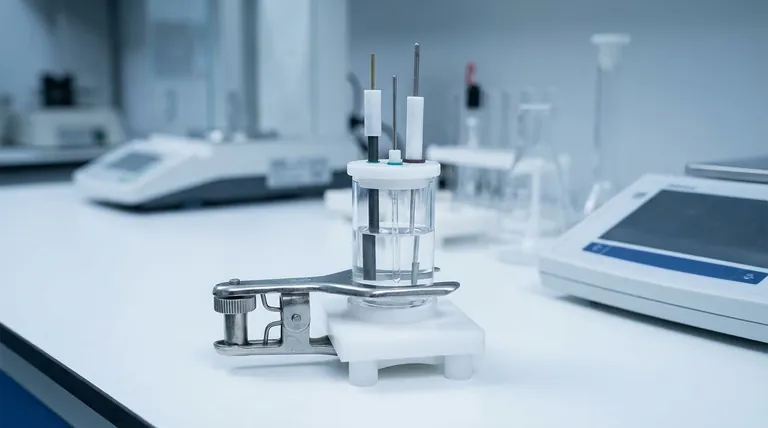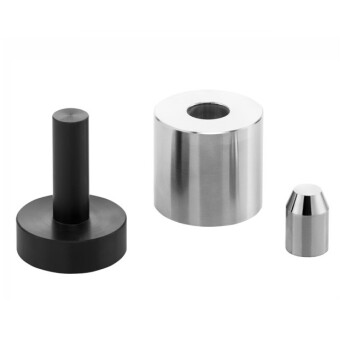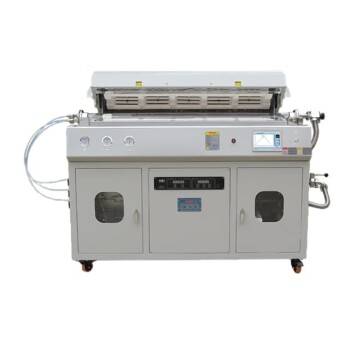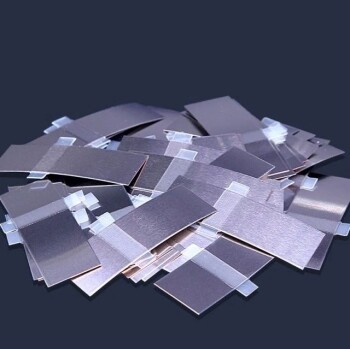An all-quartz electrolytic cell is purpose-built for a standard three-electrode electrochemical system. This design is fundamental for a wide range of electrochemical studies, providing a controlled environment to measure the potential and current associated with a specific reaction. The key components are the working electrode, a counter electrode, and a reference electrode.
The use of an "all-quartz" cell signals a need for exceptional purity and chemical inertness. This system is chosen for sensitive experiments where contamination from standard glass or polymers could compromise the results, or when working with highly corrosive media.

The Three-Electrode System Explained
The three-electrode configuration is the cornerstone of modern electrochemistry. It allows for precise measurement and control by separating the functions of current flow and potential measurement.
The Working Electrode (WE)
This is the primary site of your experiment. The electrochemical reaction you intend to study—be it oxidation, reduction, deposition, or corrosion—occurs on the surface of the working electrode.
The Counter Electrode (CE)
Also known as the auxiliary electrode, the counter electrode's role is to complete the electrical circuit. It passes all the current needed to balance the reaction occurring at the working electrode, ensuring charge neutrality in the cell.
The Reference Electrode (RE)
The reference electrode provides a stable, constant potential. The potential of the working electrode is measured against this stable reference, allowing for accurate and reproducible results, independent of fluctuations in the overall cell voltage.
Why "All-Quartz" is the Critical Feature
The choice of quartz (fused silica) over standard glass or plastic is deliberate and essential for specific types of research. This material choice defines the cell's primary applications.
Unmatched Purity and Contamination Control
Standard borosilicate glass can leach ions (like sodium, boron, and silicon) into the electrolyte solution. In trace analysis or high-purity materials research, this contamination can completely obscure or alter the experimental results. Quartz is exceptionally pure, eliminating this risk.
Superior Chemical Resistance
Quartz is highly inert and can withstand a wide range of aggressive chemicals and corrosive media that would damage or react with other materials. This makes it ideal for studying reactions in strong acids or other challenging environments.
Optical Transparency
Quartz is transparent to a broad spectrum of light, including ultraviolet (UV) wavelengths. This property is indispensable for photoelectrochemistry and spectroelectrochemistry, where the experiment involves irradiating the sample with light while simultaneously making electrochemical measurements.
Best Practices for Operation and Maintenance
The precision of this cell demands meticulous handling to maintain its integrity and ensure the validity of your experiments.
Step 1: Electrolyte Removal
After completing a measurement, immediately turn off all power to the potentiostat. Carefully drain the electrolyte from the cell, ensuring it is disposed of according to laboratory and environmental safety regulations.
Step 2: Thorough Cleaning
Rinse the cell thoroughly with deionized water or another appropriate solvent to remove all residual chemicals. A final rinse with high-purity solvent is recommended before drying the cell, typically with a gentle stream of dry nitrogen or air.
Step 3: Proper Electrode Care
Remove the electrodes from the cell after each experiment. They must be cleaned according to their specific material requirements and stored properly to prevent degradation. For instance, some electrodes require storage in a protective solution to prevent oxidation.
Making the Right Choice for Your Goal
Selecting an all-quartz cell is a specific choice based on experimental demands.
- If your primary focus is trace analysis or high-purity deposition: The non-leaching nature of quartz is essential to prevent sample contamination.
- If your primary focus is studying reactions in highly corrosive media: The superior chemical inertness of quartz provides a stable and non-reactive vessel.
- If your primary focus is photoelectrochemistry or spectroelectrochemistry: The broad optical transparency of a quartz cell is a fundamental requirement for your setup.
Ultimately, the all-quartz electrolytic cell is a specialized instrument for achieving the highest degree of precision in demanding electrochemical environments.
Summary Table:
| Feature | Benefit | Ideal For |
|---|---|---|
| All-Quartz Construction | Exceptional purity, prevents ionic leaching and contamination. | Trace analysis, high-purity materials research. |
| Three-Electrode System | Precise control and measurement of working electrode potential. | Fundamental electrochemical studies (oxidation, reduction, corrosion). |
| Superior Chemical Inertness | Resists strong acids and corrosive media. | Experiments with aggressive electrolytes. |
| UV-Vis Optical Transparency | Allows simultaneous light irradiation and electrochemical measurement. | Photoelectrochemistry, spectroelectrochemistry. |
Achieve Uncompromised Precision in Your Lab
Are your electrochemical results being compromised by cell contamination or material limitations? The all-quartz electrolytic cell from KINTEK is engineered for researchers who demand the highest levels of purity and performance.
We provide the specialized lab equipment you need to succeed:
- Eliminate Contamination: Our quartz cells ensure your sensitive experiments in trace analysis or high-purity deposition are free from interfering ions.
- Withstand Corrosive Media: Confidently study reactions in aggressive environments with a cell built for superior chemical resistance.
- Enable Advanced Techniques: Unlock the full potential of photoelectrochemistry with optimal UV transparency.
KINTEK specializes in high-quality lab equipment and consumables, serving the precise needs of research and quality control laboratories.
Ready to enhance your electrochemical capabilities? Contact our experts today to find the perfect solution for your experimental requirements.
Visual Guide

Related Products
- Electrolytic Electrochemical Cell for Coating Evaluation
- Quartz Electrolytic Electrochemical Cell for Electrochemical Experiments
- Customizable CO2 Reduction Flow Cell for NRR ORR and CO2RR Research
- Rotating Platinum Disk Electrode for Electrochemical Applications
- Gold Disc Electrode
People Also Ask
- What is the operating principle of a flat plate corrosion electrolytic cell? A Guide to Controlled Materials Testing
- What type of electrode system is the coating evaluation electrolytic cell designed for? Unlock Precise Coating Analysis
- What is the volume range of the coating evaluation electrolytic cell? A Guide to Choosing the Right Size
- What are the primary features of a flat plate corrosion electrolytic cell? Achieve Precise, Repeatable Corrosion Data
- What are the components and their respective functions in a flat plate corrosion electrolytic cell system? A Guide to Precise Corrosion Measurement



















